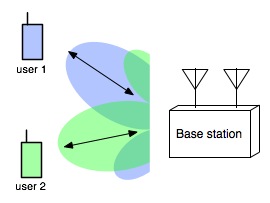SDMA
同じ時刻に複数のユーザが同時に通信を行う場合、他のユーザの信号が干渉となり正確な通信を行うことが出来なくなってしまいます。従来のセルラーシステムでは、FDMAやTDMA、最近ではCDMAと呼ばれる方式によってユーザの同時通信 (多元接続) を実現していました (下部参照)。しかし、どの方式も時間や周波数の次元でユーザ分離を実現しており、システムの効率化には限界があります。
一方、スマートアンテナを基地局 (受信側) に配置することで、干渉を与えるユーザの信号を抑制し希望するユーザの信号を取り出す空間的な分離が可能となります。さらに、この処理を各ユーザに対して行うことによって、同じ時刻・周波数帯を用いて複数のユーザが通信することができます。これを実現する概念図を下に示します。基地局にスマートアンテナを配置して振幅と位相を調整する (重みをつける) ことで、互いに干渉を抑圧するような指向性を形成します。その結果、各ユーザの信号を分離することができます。このようにユーザの位置の違いを利用して信号分離を行う方式をSDMA (Space Division Multiple Access: 空間分割多元接続) と言います。
When multiple users simultaneously perform wireless communications, inter-user interference corrupts signals and prevents us from communicating with each other any longer. Conventional cellular systems have achieved such a simultaneous communication, i.e., multiple access, by FDMA, TDMA, and recently CDMA (see below). Any of these schemes, however, exploits time or frequency, which is a limited resource, to achieve multiple access. Therefore, they have their limits to improve system efficiencies.
On the other hand, with a smart antenna at the base station (receiver side), we can spatially separate multiple users; i.e., signals from interference users are reduced and that from the desired user is enlarged and picked out. Expanding this process to all users, we can achieve multiple access with the same transmission time and carrier frequency band. The concept of the system is illustrated below. The smart antenna at the base station controls amplitudes and phases at antenna inputs, i.e., optimally weight the inputs, so that it forms array directive patterns reducing interference to each other. Consequently, we can separate and detect signals from multiple users. The technique that achieves multiple access by exploiting spatial difference in users is called "space division multiple access (SDMA)."

SDMAの概念図
Concept of SDMA.
上述したように、複数ユーザの信号の分離・検出を行う方法は、SDMA以外にも、FDMA、TDMA、CDMA等があります。以下に、それらについて簡単に説明します。なお、これらの多元接続法を組み合わせることも可能であり、それによってユーザ数の増加や伝送速度の更なる向上が期待できます。
As aforementioned, FDMA, TDMA, and CDMA are also known as conventional multiple access techniques. In the following, we would like to briefly explain them. Note that these techniques can be combined with each other to further improve the system performance such as user capacity and transmission rate.
FDMA
FDMA (Frequency Division Multiple Access: 周波数分割多元方式) とは、周波数帯域を分割して各ユーザに割り当てることで、多元接続を実現する方式です。この方式は、各ユーザの信号を異なる周波数帯域を用いて伝送します。そのため、基地局では比較的容易に信号を分離することができます。
Frequency division multiple access, or FDMA, achieves multiple access by dividing the given frequency band and allocating it to users. Each user transmits a signal through its own sub-band. Therefore, it is relatively easy for the base station to separate and detect the signals.
TDMA
TDMA (Time Division Multiple Access: 時分割多元接続) とは、複数のユーザの信号を短時間ずつ交代で伝送するという方式です。各ユーザの信号を異なる時間スロットに割り当てることで、互いの信号を干渉することなく伝送することが可能となります。
Time division multiple access, or TDMA, achieves multiple access by allocating multiple time slots to users. Each user transmits a signal in turn through its own time slot. Therefore, there is no inter-user interference.
CDMA
CDMA (Code Division Multiple Access: 符号分割多元接続) とは、各ユーザの信号に直交した (または相関の低い) 符号を乗算することで、情報信号に冗長性を持たせて送信する方式です。この符号の乗積は信号周波数帯域を広げるため (スペクトル) 拡散と呼ばれます。基地局では多重化された信号が受信されますが、各ユーザの符号は互いに直交しているため、それぞれの符号を再び乗算することで信号を分離することが可能となります。
Code division multiple access, or CDMA, achieves multiple access by multiplying signals by orthogonal (or low-correlated) codes to give them redundancy. The code multiplication is called "(spectral) spreading" because it results in expansion of the signal frequency bandwidth. Although the base station receives multiplexed signals, it can detect the desired signal by multiplying the received signal by the correspondent code.
[文献]
田中, 大鐘, 小川, "アダプティブアレーを用いたSDMA方式におけるチャネル割当基準," 信学論B, vol. J82-B, no. 11, pp. 2133-2141, Nov. 1999.
鈴木, 大鐘, 小川, "アダプティブアレーを用いたSDMA方式におけるチャネル利用効率の検討," 信学論B, vol. J85-B, no. 3, pp. 346-353, March 2002.
Y. Doi, J. Kitakado, T. Ito, T. Miyata, S. Nakao, T. Ohgane, and Y. Ogawa, "Development and Evaluation of the SDMA Test Bed for PHS in the Field," IEICE Trans. Commun., vol. E86-B, no. 12, pp. 3433-3440, Dec. 2003.
Y. Doi, S. Nakao, Y. Tanaka, T. Ohgane, and Y. Ogawa, "Development and Evaluation of a Smart Antenna Test Bed for Wireless LAN," IEICE Trans. Electron., vol. E87-C, no.9, pp.1449-1454, Sept. 2004.
[Reference]
Y. Doi, J. Kitakado, T. Ito, T. Miyata, S. Nakao, T. Ohgane, and Y. Ogawa, "Development and Evaluation of the SDMA Test Bed for PHS in the Field," IEICE Trans. Commun., vol. E86-B, no. 12, pp. 3433-3440, Dec. 2003.
Y. Doi, S. Nakao, Y. Tanaka, T. Ohgane, and Y. Ogawa, "Development and Evaluation of a Smart Antenna Test Bed for Wireless LAN," IEICE Trans. Electron., vol. E87-C, no.9, pp.1449-1454, Sept. 2004.
